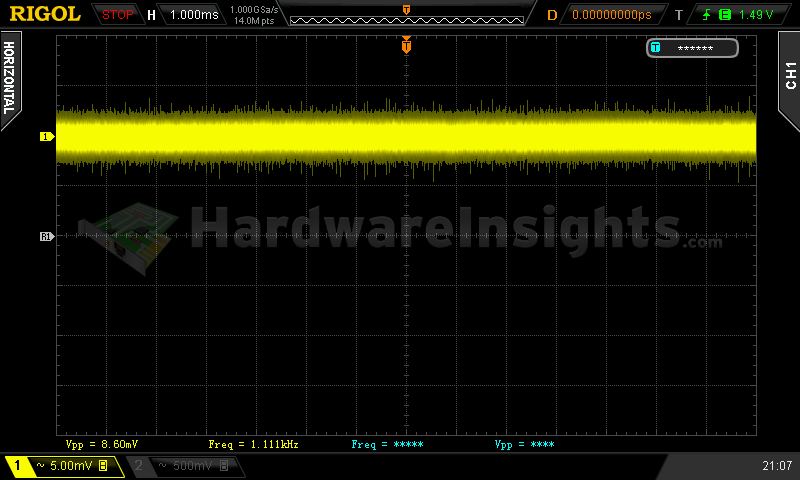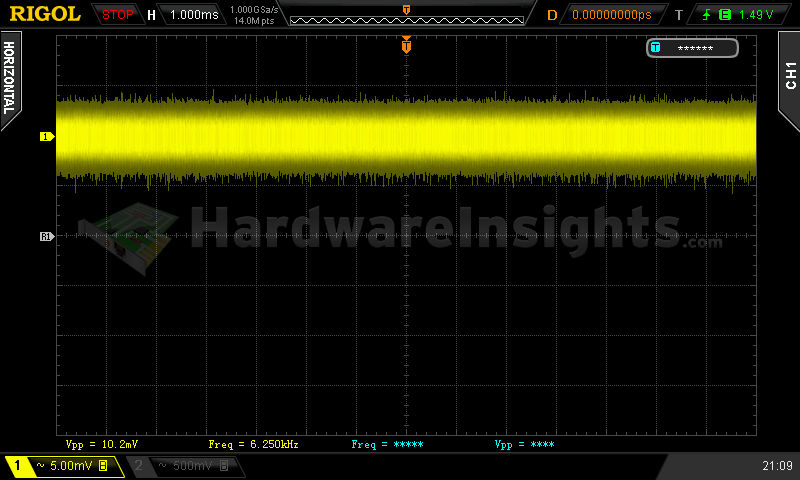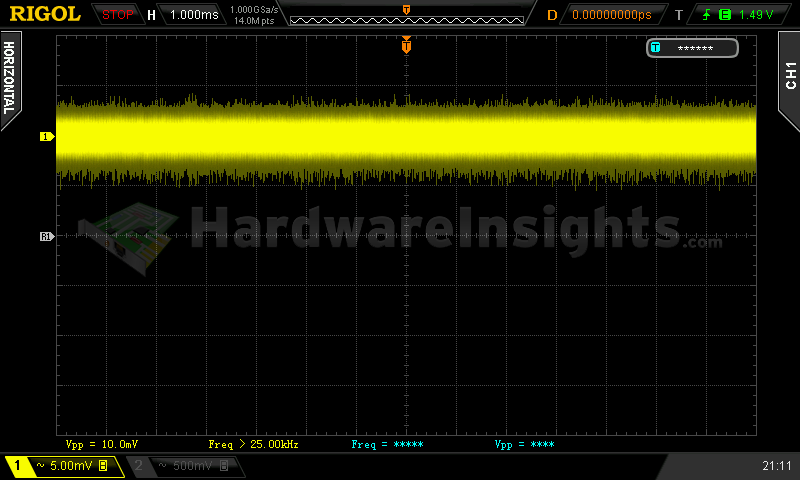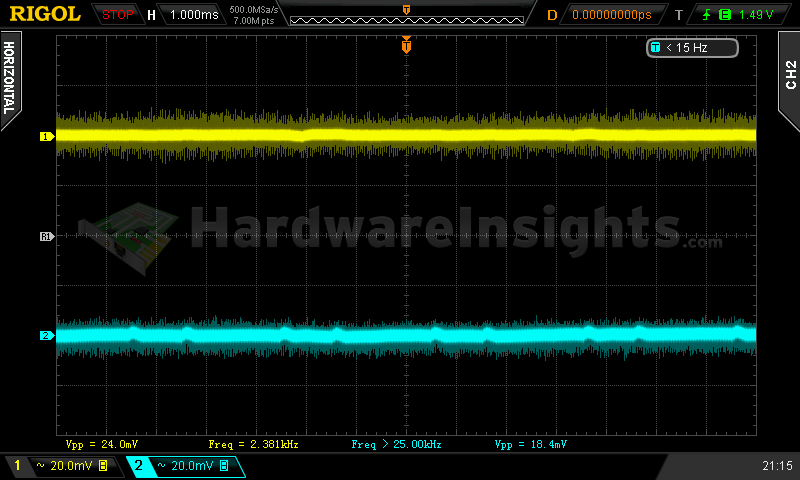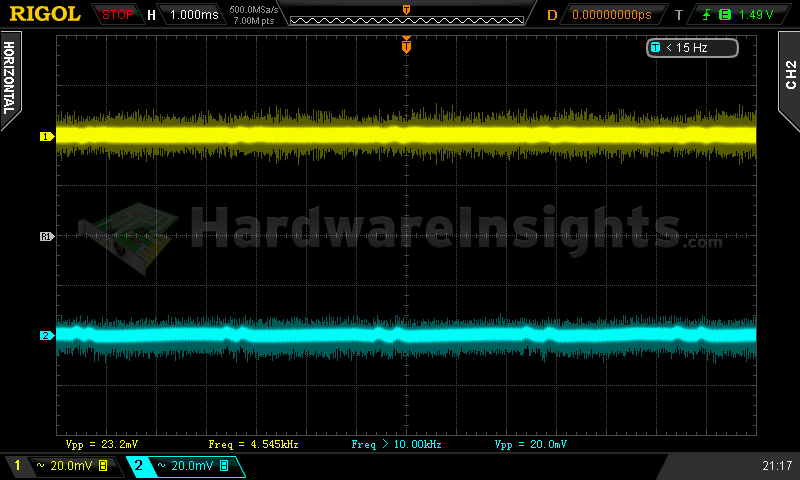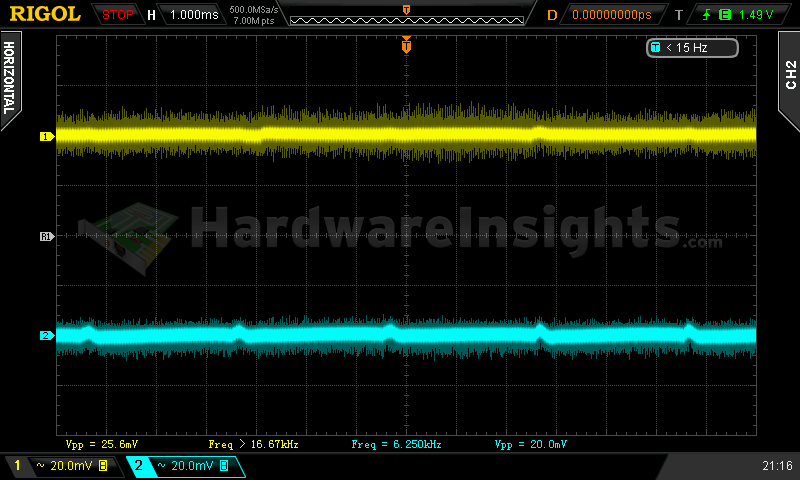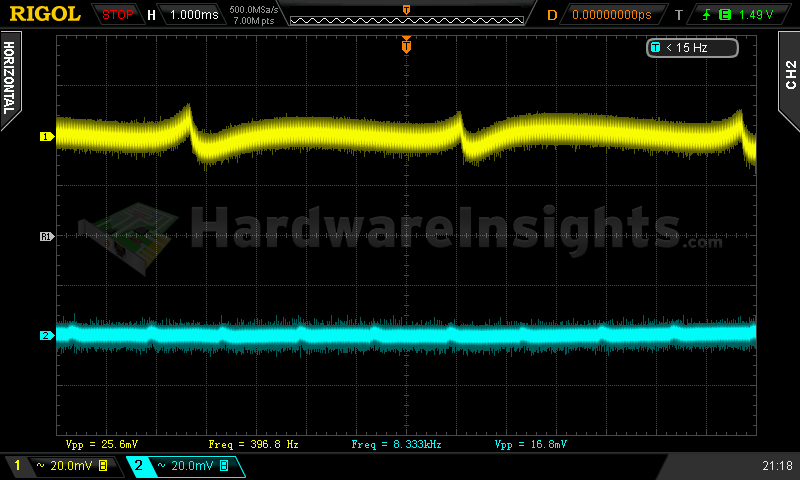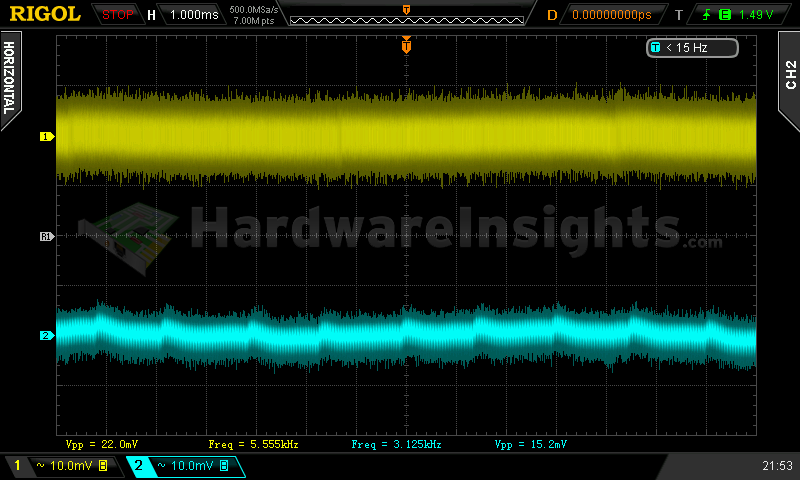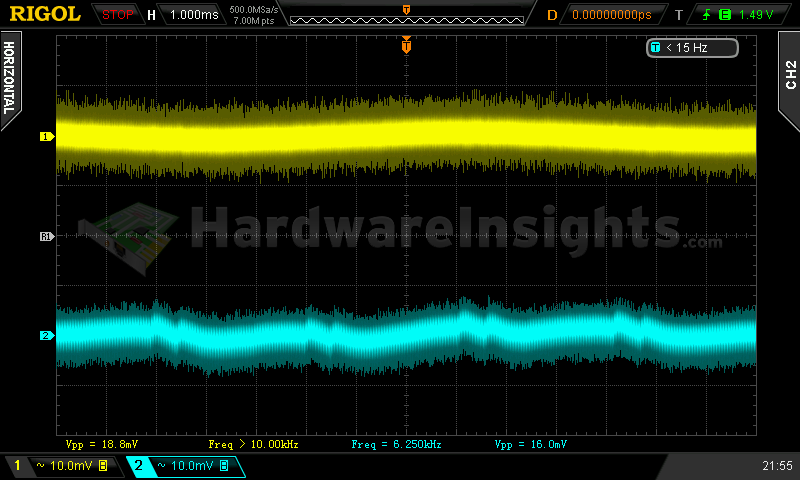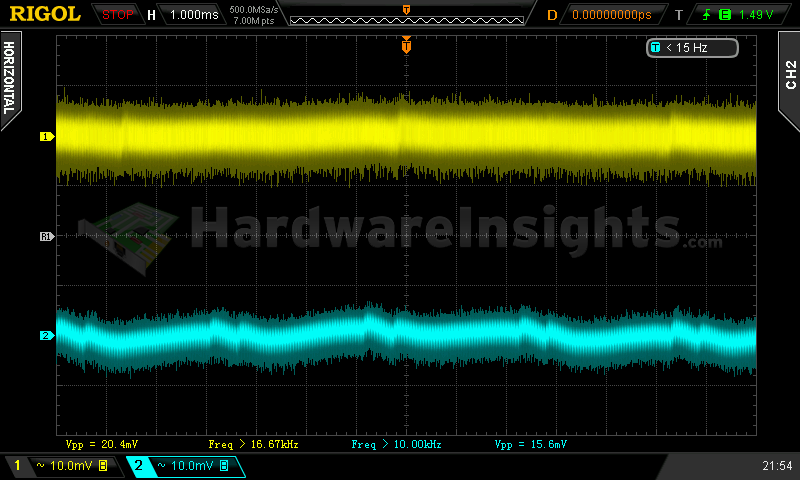Contents
- 1Introduction
- 1.1Packaging and accessories
- 2Connectors & cabling
- 2.1Casing & cooling
- 3Input filtering
- 4Primary side
- 4.1+5 V stand-by rail
- 5Secondary side
- 5.1Build quality
- 6Load testing
- 6.1Loading +5 V SB
- 6.2Voltage hold-up time
- 6.3Combined loading
- 6.4Combined loading ripple
- 6.5Crossloading, overloading
- 6.6Crossloading, overloading ripple
- 7Conclusion and evaluation
- 7.1Thanks
- 7.2Discussion
Load testing
Loading +5 V SB
As always, all load testing is done in accordance with testing methodology. I like the voltage regulation, after couple last units where the voltage always sunk with load, this time the Antec Earthwatts Platinum 550 W holds quite good. On the other hand ripple suppresion is below average. In spec, yes, but 10 mV is nothing special. Efficiency is the same, barely around 70 %.
| Output (W) | Load (A) | Voltage (V)/ ripple (mV) | Input (W) | Efficiency/power factor |
| 0 | 0 | 5,04/8.60 | 0.5 | —/0.02 |
| 14.39 | 2.88 | 4.99/10.2 | 20.5 | 70.2 %/0.61 |
| 16.63 | 3.34 | 4.98/10.0 | 24.0 | 69.3 %/0.60 |
+5 V SB ripple (left to right): 0 A; 2.88 A; 3.34 A
Voltage hold-up time
The hold-up time of the +12 V rail on the scope image is almost suspiciously good. Over 30 ms with just 270uF input capacitor, really not bad. Platinum efficiency seems to help. 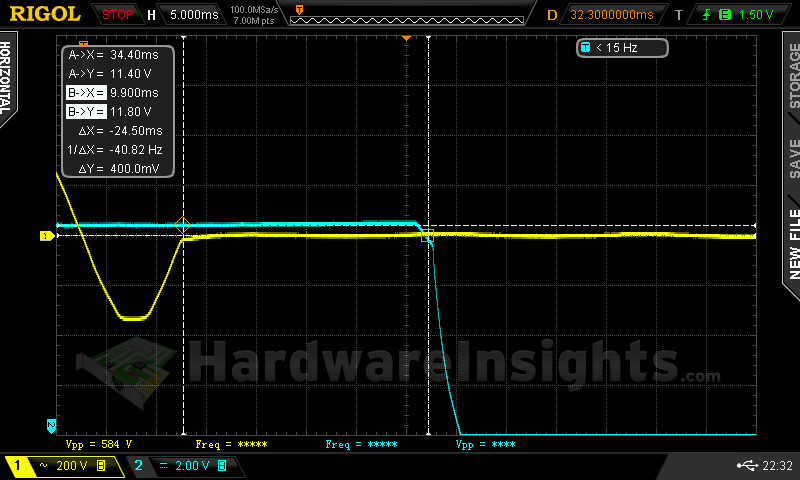 When trying to interrupt the power for this time period, usually very bad drop occurred and also the PFC section did not handle that: it always started clicking and the unit turned off few moments later. The minimum time which the PFC handled and no out-of-spec drop occured was 32 ms in the end. And the rise is nicely smooth, no transient spike.
When trying to interrupt the power for this time period, usually very bad drop occurred and also the PFC section did not handle that: it always started clicking and the unit turned off few moments later. The minimum time which the PFC handled and no out-of-spec drop occured was 32 ms in the end. And the rise is nicely smooth, no transient spike. 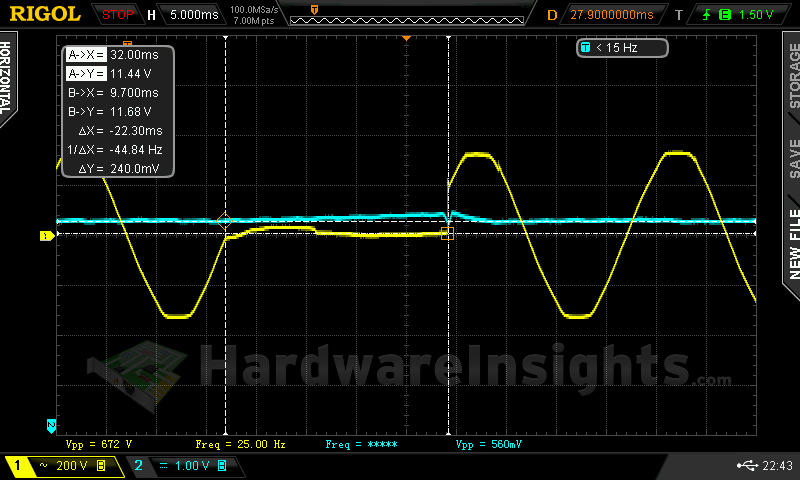
Combined loading
Combined loading was mostly flawless. The good thing is all voltages mostly stayed above nominal (with the exception of −12 V, which stayed under the nominal) and did not change much with load, in other words, they are stable which is also good. But absolute values are not so good, both +5 V and +12 V started quite high, −12 V low. But I guess this could not be much better because of group design.
| Output power | Load/ voltage +5 V SB | Load/ voltage +3.3 V | Load/ voltage +5 V | Load/ voltage +12 V | Load/ voltage −12 V | Input power | Efficiency/power factor | Temperature intake/ outtake |
| 5.4 %/ 29.91 W | 0 A/ 5.10 V | 0.014 A/ 3.31 V | 0.362 A/ 5.10 V | 1.956 A/ 12.26 V | 0.320 A/ −12.60 V | 39.0 W | 76.7 %/ 0.78 | – °C/ – °C |
| 20 %/ 110.45 W | 0.483 A/ 5.09 V | 1.486 A/ 3.31 V | 2.289 A/ 5.10 V | 7.14 A/ 12.23 V | 0.323 A/ −12.61 V | 121.0 W | 91.3 %/ 0.95 | – °C/ – °C |
| 40 %/ 216.14 W | 0.97 A/ 5.08 V | 3.11 A/ 3.30 V | 3.45 A/ 5.10 V | 14.7 A/ 12.20 V | 0.319 A/ −12.65 V | 231.5 W | 93.4 %/ 0.99 | – °C/ – °C |
| 60 %/ 327.67 W | 1.89 A/ 5.05 V | 6.04 A/ 3.29 V | 4.95 A/ 5.10 V | 22.1 A/ 12.17 V | 0.321 A/ −12.68 V | 350.5 W | 93.5 %/ 0.99 | – °C/ – °C |
|
80 %/ 440.52 W |
2.35 A/ 5.03 V | 7.39 A/ 3.30 V | 6.09 A/ 5.09 V | 30.4 A/ 12.14 V | 0.336 A/ −12.73 V | 472.0 W | 93.3 %/ 1 | – °C/ – °C |
| 100 %/ 553.29 W | 2.76 A/ 5.03 V | 7.99 A/ 3.30 V | 6.74 A/ 5.09 V | 39.1 A/ 12.14 V | 0.319 A/ −12.73 V | 597.0 W | 92.7 %/ 1 | – °C/ – °C |
There are no temperature figures this time as my stupid multimeter is currently broken for this feature. I got air conditioner blowing cool air mostly on the unit itself so that is also the reason why its fan stayed at quite low speed even under full load. And thanks to the unit’s high efficiency (around 93 %), it did not really need to move lot of air. Low-load efficiency was poor though. So this tells us one thing – keep this unit cool and it will be silent. And do not use it for sub-50 watt machines.
Combined loading ripple
The ripple suppresion of Antec EA-550 is not so good, we have basically mainstream values here. So it is not terrible, but not great either. Interesting thing is the ripple decreases in average with load, seems that active-clamp forward topology is better at higher loads. This is indeed platform thing, both Aurum and Raider showed mostly the same behaviour.
| Output % | Ripple +5 V SB | Ripple +3.3 V | Ripple +5 V | Ripple +12 V | Ripple −12 V |
| 5.4 | 24.0 mV | 23.2 mV | 25.6 mV | 20.0 mV | 25.6 mV |
| 20 | 30.8 mV | 26.0 mV | 27.2 mV | 17.2 mV | 26.4 mV |
| 40 | 29.2 mV | 18.0 mV | 24.4 mV | 15.8 mV | 26.8 mV |
| 60 | 23.6 mV | 23.2 mV | 20.0 mV | 17.2 mV | 24.4 mV |
| 80 | 22.0 mV | 20.8 mV | 19.2 mV | 16.0 mV | 25.6 mV |
| 100 | 22.0 mV | 18.8 mV | 20.4 mV | 16.0 mV | 26.4 mV |
Eh, seems that I forgot to save the −12 V ripple screenshot…
Ripple 5.1% load (left to right): +5 V SB; +3.3 V; +5 V; −12 V. The second channel is connected to +12 V.
Ripple 100% load (left to right): +5 V SB; +3.3 V; +5 V. The second channel is connected to +12 V.
Crossloading, overloading
Crossloading uncovered the worst of group design. With +5 V crossload, the +12 V voltage went way up, 0.02 V from the allowable limit. With +12 V crossload, everything else but +3.3 V (and −12 V) went high while +12 V tanked. Still the same bad Aurum…OCP on any rail was not triggered, this unit has no OTP so I did not risk it. But wearing sweater it worked fine. Efficiency was nice though, considering the Cooler Master V Semi Modular V550S which got three points for its crossload efficiency, I think it is fair to give two points to EA-550. It is going to lose shitload of points anyway…
| Output power | Load/ voltage +5 V SB | Load/ voltage +3.3 V | Load/ voltage +5 V | Load/ voltage +12 V | Load/ voltage −12 V | Input power | Efficiency/power factor | Temperature intake/ outtake |
| 20 %/ 111.05 W | 0.466 A/ 4.97 V | 1.488 A/ 3.31 V | 15.14 A/ 4.92 V | 1.996 A/ 12.58 V | 0.326 A/ −12.90 V | 124.0 W | 89.6 %/ 0.93 | – °C/ – °C |
| 16 %/ 89.81 W | 0.487 A/ 5.02 V | 15.53 A/ 3.28 V | 1.538 A/ 5.03 V | 1.978 A/ 12.43 V | 0.322 A/ −12.74 V | 104.0 W | 86.4 %/ 0.94 | – °C/ – °C |
| 101 %/ 554.21 W | 0.483 A/ 5.15 V | 1.469 A/ 3.31 V | 1.564 A/ 5.16 V | 45.7 A/ 11.70 V | 0.329 A/ −12.46 V | 603.0 W | 91.9 %/ 1 | – °C/ – °C |
| 113 %/ 619.46 W | 3.21 A/ 4.96 V | 13.15 A/ 3.29 V | 13.71 A/ 4.44 V | 46.6 A/ 10.65 V | 0.272 A/ −11.35 V | 695.5 W | 89.1 %/ 1 | – °C/ – °C |
…because overloading was the same disaster as with all the Aurums. First, the unit is just not able to deliver anything over 600 W. Maximum I got was around 650 W, than all the voltages started falling rapidly, especially +5 V and +12 V. That also means the actual power output went down with voltage and the more load I hooked, the lower power I got. Makes sense, right? As usual, the unit did not turn off before voltage went under 10.6 V on +12 V – yeah, like any computer can work with that, very useful OCP and OPP indeed! The active-clamp forward with group design shows us it does not like low loads and it does not like high loads. I guess synchronous two-transistor forward with 3-way primary switching clearly wins any day of the week here.
Crossloading, overloading ripple
It is basically the same story as combined loading.
| Output % | Ripple +5 V SB | Ripple +3.3 V | Ripple +5 V | Ripple +12 V | Ripple −12 V |
| 20 | 27.2 mV | 25.2 mV | 24.4 mV | 16.4 mV | 27.6 mV |
| 16 | 30.4 mV | 20.0 mV | 29.6 mV | 20.8 mV | 26.8 mV |
| 101 | 26.4 mV | 16.4 mV | 25.2 mV | 20.0 mV | 24.4 mV |
| 113 | — | — | 26.8 mV | 29.2 mV | — |
